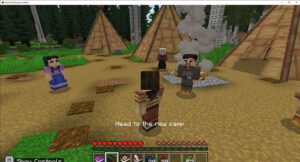Review: Minecraft Education World of Manito Ahbee Aki
Set within the Minecraft world, Manito Ahbee Aki – the place where the Creator/Spirit sits, is designed as an interactive educational experience for 8 to 13-year-olds. The program was developed by the Indigenous Education team of Winnipeg’s Louis Riel School Division in association with Microsoft Canada and Minecraft: Education Edition.
It is designed to teach players, either at home or in the classroom, about the Anishinaabeg in Manitoba specifically and more generally about our history, culture, and worldview. As students venture through the world, they will gather items needed to craft tools, such as a canoe and knife, explore the petroforms, understand the importance of community, learn the four sacred medicines and some Anishinaabemowin (i.e., semaa, benesi, Nibi, wiigwaas, jiimaan, etc.) while farming and participating in a bison hunt. To travel from one site to another within the game, the student needs to craft a canoe as well as pay close attention to the directions given at the first encampment and watch the stars to find their way. At each site, the player needs to talk to the in-game characters to understand what they need to do next. In speaking to the in-game characters, players are also presented with information and lessons. Without that knowledge, the player cannot succeed at completing the tasks of the game.
I experienced a few glitches initially – the recipe book for crafting tools and other objects was blank. The Indigenous Education team in Winnipeg responded quickly to my plea for assistance – I had to delete and reinstall the world to resolve the issue. Being based in Minecraft, I found the game blocky and blurry but my daughter loved playing it. In terms of gameplay, the narrative is very linear, all tasks must be completed in the assigned order. It would have been nice to be able to have more of a non-linear experience – one where you can explore, learn, and complete various tasks whenever you want. In all honesty, it took me a while to get used to the controls and camera angles since I am not accustomed to Minecraft. For example, I found it very difficult to climb into and stay in the canoe; my daughter, however, experienced no such difficulty.
Positive features of the game provide an immersive and educational experience. Flora – blueberries, birch trees, and tobacco – and fauna – eagles, blue jays, owls, crows, robins, ducks, deer, and bison – indigenous to Winnipeg can be found throughout the game. Red dresses can be seen hanging from trees. You can hover high over the petroforms, albeit once I figured out how to activate the feature. The hover provides a nice vantage point to view the ‘abstract’ nature of the forms. Signboards by each form present some information while encouraging discussion and additional questions and desire for more information. For instance, my daughter and I looked up additional information about Anishinaabeg petroforms, petroglyphs, and pictographs. ‘Easter eggs’ are also included. For example, if you look around the petroform area, a character from legends can be found as well, a nice inclusion that led to a conversation with my daughter about our legends and beings within them.
Overall, Manito Ahbee Aki is an interesting and engaging educational game. It is well thought out and designed. It provided a fun and familiar platform that engaged my daughter and I in an educational journey. I would recommend that Manito Ahbee Aki be utilized in the home, where parents and Elders can teach and learn alongside their children, and in the school where a teacher, Elder, or Knowledge Keeper can guide children in the classroom. This Minecraft World is not just for Anishinaabeg children; it is a marvellous step toward learning and appreciating your own and other cultures. I hope that Indigenous educators from across Turtle Island not only find Manito Ahbee Aki educational, but use it as an inspiration to develop Indigenous worlds for other nations.


